Noble Khan
https://nobleaudio.com/en/shop/universal/khan/
-MRSP: Universal fit $2399.00
Intro & Me: I am an audio enthusiast, and I am here as a guest to tell you about the Audio Rabbit Hole and my journey with it over the last few years. I started about five years ago when I wanted something better than the included earbuds with my Samsung Galaxy phone and my first “real” purchase was a Yamaha EPH-100. This rocked my world; the bass impact, the treble sparkle, the mids defining themselves as more than just what is in between the bass and treble – it was all there. That $99 felt so extravagant at the time and let me tell you friends, I wish I could go back to that price segment and be content. That’s where the Audio Rabbit Hole first bit me and has kept me in its grasp ever since. Only now, the hold is tighter, more expensive, more serious and most of all, more controversial! This hobby has been a fun one and I have met some great folks over the years, but it has also become apparent that when you begin to own several different top-of-the-line models, audio life gets exponentially more complicated.
I am an IEM guy at heart. I am a cable believer. I drink 40oz bottles of snake oil and use unicorn dust to style my hair. I have never done a blind test because that might tell me something I do not wish to hear. I have published a few reviews over the years, have never made a “ranking list” and generally agree with at least 50% of the opinions I read on the internet. I do not know how to make audio graphs, describe specific frequency ranges or peaks and I couldn’t tell you why balanced sounds better than single-ended. But what I can say is this: I have owned over 20 top-of-the-line IEMs and I am here today to give you my thoughts about one of my very favorite ones, the Noble Khan.
Test Equipment: during my ownership of the Noble Khan, I have had several different sources. Most of my listening has been done on a desktop DAC and amp combo in the form of a Sony TA-ZH1ES, with numerous other sessions spanning across a recently-acquired (and LOVED) Astell & Kern Kann Cube (known as “Kube” by the cool kids, and let me tell you what a pain in the ass it is spewing out words between a source called the Kann and an IEM also called the Khan), a wonderful Cayin N6ii and a Sony PHA-2A which I use at work. There are different sound signatures with these sources, and I will touch on that a bit later. You will notice that all of these sources are balanced, so I opted to use the Noble 8-wire balanced cable rather than the “stock” cable that came with the Khan. Also more on that later. Finally, my music all comes from the same place: Tidal Hi-Fi streaming using master quality where available and the rest Hi-Fi. The only other accessories used in this review were my ears, several (okay, several hundred) cans of beer and maybe a glass of wine or ten when the music called for a slightly fancier listen. Oh, and my tried-and-true Spiral Dot tips. Speaking of tips…

Ordering, Accessories, Tips, Packaging: for buyers mostly anywhere in the world, Noble has you covered. Ordering from their own site is straight forward, several distributors exist around the globe with equally-seamless options and if you are so inclined, you can even PM the Wizard himself on Head-Fi with any questions. I have found Noble’s customer service and support to be a cut above the rest and they operate as a stand-up and honest business. This is something you are not always guaranteed in the boutique IEM world and Noble is a breath of fresh air in that sense. So, once you receive your Khan, what’s in the package?
First, you’ll see the familiar packaging to include a Pelican 1010 hard case that probably could have stopped Chernobyl from melting down, a nice assortment of high-quality Noble tips, a cleaning tool, the IEMs/cable and some cool Noble-branded straps to keep your portable rig sandwiched together. Fairly typical of any high-end offering, and I find the accessories adequate. I will mention that the tips are not an off-the-shelf variant like Spinfits or Comply, but Noble-branded and fit exceptionally well on the IEMs. They also offer numerous size/shape options and I cannot imagine many folks will have to venture out for other tips. Personal preference really, but that is my take on the tip situation here. Still, I prefer JVC’s Spiral Dots for familiarity and known-fit.
A quick note on the price: this is not a cheap IEM. At $2,399, it’s probably a few months’ rent, a mortgage payment, a semester of college, a minor service on that second-hand Mercedes you wish you didn’t buy…but guess what? It’s actually cheaper than many other flagships of 2018/2019/2020. Perceived value and within-reason pricing sadly stirs up too much controversy in this industry, so all I will say is that if you are in the market and looking within this segment, you would do yourself a great disservice to not strongly consider the Noble Khan.
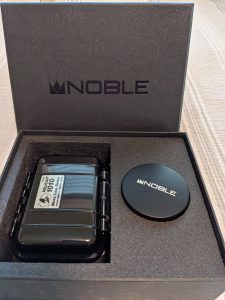
Fit and Cable: the Khan is a stark departure from the universal IEMs Noble has created in the past, and I think it is excellent. While we all know (and some love) the egg-shaped aluminum shell of nearly every recent universal Noble IEM prior, these are quite different. While large, they’re very ergonomic and I immediately got a good seal with my preferred size of tips. The nozzle is on the longer side, so the IEMs stick out of my ears a bit, but this hasn’t caused any issues. Though I will say, I am not one of those folks who sleep on the side of my head with IEMs in my ears. I do not imagine this shape would lend well to that sort of use. Besides, the sound is way too exciting to sleep through! But let’s not get ahead of ourselves. Overall, fit works exceptionally well for me and the nozzle design lends itself to accepting a wide variety of tips. While the IEMs are on the larger side and will likely not sit flush in your ear like, say, the Earsonics Grace, they do provide extended comfort over long listening sessions and I believe that many users will find them quite comfortable. I cannot say the same for the Dita Dream XLS, but there I go getting ahead of myself again (comparisons!).
The cable included with the Khan is a nice looking four-wire black and white braided design, terminated in 3.5mm TRS. Nothing super special here, but I found the cable to be light, comfortable and did not get in the way. The Khan has recessed 2-pin sockets, so the sky is the limit as far as third party cable options go. As I said before, I’m a cable believer, so this cable did not spend much time on the IEM if I’m being frank.
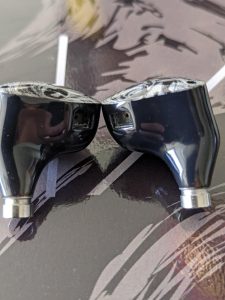
Sound Signature: thank you for bearing with me thus far while I babble about things that are all utterly irrelevant to what you came here for the sound! The Khan is a highly refined, highly technical IEM with an overall balanced sound. I do not think this IEM fits into any categories such as “bass-head” or “timbre-licious,” but instead, it is a carefully thought out tuning that portrays music in a manner that is slightly enhanced in all areas. The dynamic driver provides that impactful and air-moving bass we all crave, the mids ringing through balanced armatures offer a level playing field for all types of vocals, and the highs are drenched in clarity and sparkle from that piezo-electric tweeter. I have heard a few IEMs with similar “tri-brid” configurations, but none have matched the Khan’s refinement and targeted sound reproduction. What we have here is an IEM that responds well to a wide array of musical genres, provides a sense of excitement and most importantly, does it with a technical prowess that is up there with the best (and warrants its price IMHO, but there I go getting ahead of myself again). This is not an IEM that I would classify as warm, uber-natural or overly-musical and I mean that in a good way. While it’s not unnatural, per se, the treble energy separates it from the likes of the Empire Phantom as one example. It is a chiseled tri-athlete rather than the current dad-bod I am sporting…
Bass: let’s start with the dynamic driver’s opening act, that sweet and impactful bass. Noble’s previous flagships have been all based on balanced armature drivers and I believe this is their first hybrid. There have been dynamic driver implementations in Noble’s past, but none at this level. Starting with sub-bass, I hear a textured and extended rumble that digs down deep for those subwoofer-like air feelings. Quantity is slightly north of neutral, way off from something like the Empire Ears Legend X, but extension, texture and impact are incredibly well placed and fit into the scope of Khan’s overall sound signature. Skip to about three and a quarter minutes in to “Why So Serious?” by Hans Zimmer and you will be blessed with a deep, solid rumble that may even startle you at first. In the quality vs. quantity debate, Khan takes the quality home easily.
Moving into the mid-bass, things are relatively tame here. While I’ve heard numerous IEMs that have mid-bass bleeding into mids, there is no such outcome here. I would venture to say the sub-bass is at the center of the Khan’s bass focus and the mid-bass, in order to preserve a clean canvas for the mids and vocals to be painted, is neutral. No issues here as I am not a fan at all of bloated mid-bass and despite being on the neutral side, I still hear pleasant warmth and texture in bass guitar, kick drums and this frequency range still has a solid kick when called upon. Bass, in general, is speedy for a dynamic driver and never feels bloated or slow. It’s a bass that kicks in when it needs to and retreats equally fast into the enveloping surroundings. Controlled, textured and delicious!
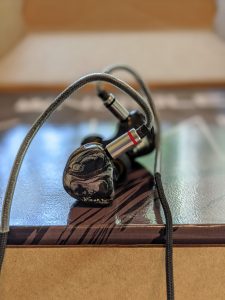
Mids: I have owned many Noble IEMs in the past and have always been impressed with their mid-range tuning, allowing vocals to sing in a clear atmosphere and guitars to ring through with a feeling of realism. A song I think that shows this is Eric Clapton’s “Change the World” because the stringed instruments and vocals are a great test of mids. Here, the Khan provides an incredible sense of realism within instruments, and vocals are layered and defined through the intricate passages. While this tuning does not offer “thick” or “meaty” enhancements around the mids, the dynamics are so engaging because the music just seems to form an atmosphere around the vocals which stay at the forefront despite not being “forward.” At the same time, the sub-bass focus and neutral mid-bass give the mids a precise sound as you would expect from a highly-technical and refined neutral-ish monitor. I am simply addicted to band-based music with these, especially songs with a crunchy electric guitar and toe-tapping bass guitar.
Treble: ah, the treble. If there is an area that might cause a bit of controversy with the Khan, this will be it. It’s not the level of controversy of, say, should we impeach Trump or is the Popeyes chicken sandwich better than Chick-Fil-A’s, but it may cause a slight riff amongst the outspoken audiophiles. For me, I find the treble wonderfully sparkly, highly-extended and energetic. I do not like to use the term bright because it suggests a more unpleasant treble in my view, but to my ears, these are not going to be the “everyone can listen for eight hours straight” side of the treble fence. I personally love a sparkly treble, so I am addicted to the higher registers of the Khan’s sound reproduction. The piezo-electric tweeter reproduces high notes with an ultra-high dose of clarity and detail, which may offend some treble-sensitive listeners. But once you’ve heard it, it’s hard to go back to a “normal” treble and I find myself craving the Khan any time I need some sparkle in my life (or ears really). Upper treble mainly provides an injection of energy and rockets the perceived clarity through the roof. No, it’s not a boosted treble to enhance details, it’s a highly extended treble that responds when the music calls for it. I will not conclude it to be warm, lush or smooth like some of the estat IEMs I have heard, but rather sparkly energy that will soar to the highest registers. On that note, and without referencing or creating any graphs that are not worth the HTML they are printed on, I will venture to guess that these fare very well when comparing to other TOTL offerings whose treble falls off sharply into the upper regions. In my opinion, the treble is the star of the show on the Khan IEMs, but it still fits coherently into the rest of the spectrum and allows all frequencies to shine.
Vocals: I touched on the vocals a bit when discussion the mids, but they deserve their own section. Accurately describing vocal reproduction is a challenge for me because, well, I’m a cheap date. I hear lovely female vocals and get taken pretty quickly, no matter the IEM. My wife says the same about me when I shop at Bed Bath and Beyond. I have not heard an IEM in all my years that ever made a stunning vocalist sound not-stunning. That said, after digging deep and critiquing my own hearing more than anything, I am ready to confidently say that the Khan is a class act at reproducing vocals. Like I mentioned prior, the Khan is not going to add thickness or warmth to the vocals, but instead will keep things true-to-form per the voice of the singer. The Khan will not make Avril Lavigne sound like Nora Jones, and going the other way, they will not make Eva Cassidy sound like an anemic squirrel. During critical listening, I detect a nuanced separation of vocals from the rest of the pack that highlights the singer while not recessing instruments or other sounds to the back of the stage. This is all a fancy way of saying the vocals are natural, ever-so-slightly forward and to my ears, emotionally stimulating. I have not been left wanting for more warmth or thickness, but instead have marveled at just how awesome a crystal clear vocal presentation can sound. I will say that compared to other more musically-enhanced monitors (Legend X for example), the vocals may seem slightly lean in comparison. But that clean stage really allows the listener to be captivated by the Khan’s vocal presentation.
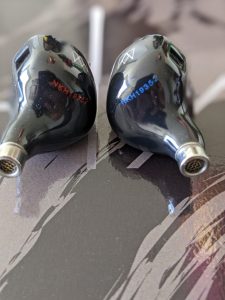
Soundstage, Separation & Timbre: I don’t make it a secret that I have difficulty reviewing, let alone describing soundstage dimensions. Instead, I am just a simpleton that can tell you the Khan has an expansive and vast soundstage, most of which I will assume is derived by the cleanliness of the background and balanced tuning. I tested a few tracks (notably Amber Rubarth’s stuff) and can pinpoint exactly where each instrument is placed and where she is standing in the stage. Musical sounds expand very wide and give the “out of head” impression on many live recordings. I am highly impressed with the large, enveloping soundstage on these.
The clarity-driven focus of these IEMs works in favor of separation and imaging, and I am not left wanting anything else in technicality. There is an effortless presentation of detail and separation where the Khan gives the impression that it is not even breaking a sweat with highly sophisticated and specifically-placed instrumental tracks. Again, an incredibly impressive technical showing on this front. As for timbre, I have seen these monitors referred to as lean and while I agree to a certain extent, the clarity and neutrality are what I believe to be intentional tuning by Noble. These are a little too energetic and technical to be considered absolutely “natural,” in my opinion, but at the same time, I would not change the tuning one bit.
Comparisons: comparisons are always fun, and I have chosen a few IEMs in my collection to compare the Khan with that I feel are at a similar price and performance bracket.
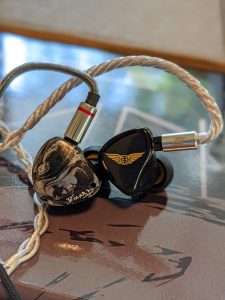
Empire Ears Legend X: while both are hybrid configurations containing a dynamic driver (actually two in the Legend X), handling the bass, the similarities sort of end there. The Legend X contrasts the Khan’s tuning and heads more into the L-shaped tuning with massively impactful and large doses of bass slam. I love, love, love the bass on the Legend X, but it is not the monitor I would choose for every genre of music like I would the Khan. While the Legend X reaches deeper, rumbles harder and thumps right up into the mid-bass, the Khan is clean, controlled, slightly softer, and rolls off into the mid-bass sooner. The Legend X provides a bass track whether you want it there or not and while I do not mean this in a bad way at all, the Khan is the most “daily driver” of the two for my ears. Moving up into the mid-range, the Legend X provides a more rich and thick experience with the vocals sounding intimate and emotional, where Khan is more believable that you are actually at the show. Khan is dryer and airier in the mids, where Legend X is enhanced, sweetened and will probably leave a little bit of residual lipstick around your ear lobes if you’re not careful. Khan is refined clean, marriage material. Treble is another area of departure for the Legend X and Khan with Khan having more sparkle and perceived clarity and Legend X being smoother, more relaxed, but still quite extended. I would venture to guess that actual extension and technicality of the treble is similar on both monitors, but the Khan brings the quantity of sparkle out in highest doses in comparison to Legend X. Overall, it’s really a question of tuning and your preferences with Legend X being warm and lush with monstrous bass and Khan being more neutral, sparkly and clean. This is why I own both!

Dita Dream XLS: here is an interesting comparison where we have the latest single dynamic driver from Dita in a gorgeous titanium shell (which is not nearly as comfortable as the Khan) and an accessory package is befitting of a king (despite Khan’s slogan of “The King of Kings”). These two monitors really only share the fact that they have a dynamic driver and cost around the same price. Dita’s tuning of the Dream XLS is all about natural, emotional and musical listening, but still with a high dose of technicality. Starting with the bass, Khan extends deeper with similar quantities of rumble, but the Dream XLS focuses a tad more on mid-bass whereas Khan focuses on clean and textured sub-bass with a dryer mid-bass. Both thump appropriately hard and provide that dynamic driver sweetness, but the Dream XLS is an awfully engaging sound given the balance between mid and sub-bass, with slight enhancements to the quantity and a pleasing texture. It’s the rounder bass of the two while Khan is the sharper and faster bass. Mids on the Dream XLS are natural and slightly warmer than Khan, where Khan focuses on cleanliness and accurate reproduction. Female vocals just melt into your ears with the XLS, whereas Khan delivers them on a silver platter. Khan feels airer whereas Dream XLS gives a warmer and thicker touch. Treble is again quite different with Khan being more sparkly, though Dream XLS’s full-range dynamic driver is capable of very impressive extension and sparkle where the track calls for it. I would call the Dream XLS the more balanced of the two, though with a feeling of warmth sprinkled across the frequency range. Did I mention the much prefer the fit of the Khan?
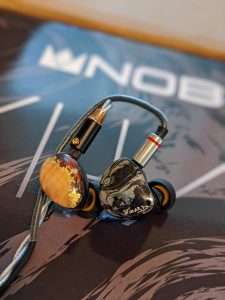
Noble Katana: Noble’s former flagship was something I went back and forth on as far as which to purchase for several months and I ended up buying both because I am clinically insane and addicted. That said, the prior monitor that shared the flagship monitor with the Encore definitely can still hold its own. The Katana is all balanced armatures, though it has surprisingly impactful and pleasing sub-bass and mid-bass. Dare I say, the mid-bass is even punchier on the Katana because of its overall speed and cleanliness, hence the name Katana. Bass digs deeper on the Khan of course, but there was less of a difference here than I thought. Into the mids, the Katana sounds slightly warmer, though still very neutral and airy. Mid-range is quite similar until you really A/B between these and I find the Noble “house sound” is alive and well in the vocal reproduction of both. Into the treble, Khan sounds a little more sparkly and more extended, but Katana has a bit more warmth in the lower treble that causes a more “fatigue-free” listen in my opinion. I am honestly delighted with both monitors and plan to keep both, but overall the bass extension and treble extension are superior on the Khan, for better or worse per your tolerances and preference. Oh, Katana is tiny, I love the fit, and mine is the “Wizard” version with a unique acrylic shell.

Earsonics Grace: I have a soft spot for Earsonics, but I will try to remain as unbiased here as I can. I love Grace. It’s a highly-musical, 10 balanced armature monitor that pretty much has zero in common with the Khan other than my vast amount of unconditional love for both. Starting with the bass, Grace has a soft, but oh-so-pleasing bass response that provides smooth and solid impact, as well as nuanced notes of something like a bass guitar. Khan digs deeper once again, offers more slam in the sub-bass, but the mid-bass from Grace is deliciously musical, warm and pleasing. Khan is noticeably more neutral in the bass tone, while Grace provides emotion. Into the mids, Grace is again warmer, but still manages a large and holographic stage for vocals to arise from in a crystal clear manner. Khan is more neutral, but also more accurate in my opinion. Khan gives that feeling of a “correctness,” whereas Grace puts you in the same venue but adds a few glasses of wine to the perception. It’s neutral vs. natural here in my book. Treble is softer, though still highly extended on the Grace, where Khan is the more sparkly and energetic. Khan feels more technical, higher resolution and more open in its sound, but Grace is a lesson in deliberate tuning that creates one of the most pleasing sounds I have ever heard in a monitor. Also, Grace is remarkably ergonomic and much smaller than Khan, though Khan is still extremely comfortable for me.
More on Cables: if you’re still with me thus far, you have probably gathered that the Khan might be a little too spritely for some. Queue the cable rolling! In my opinion, Khan performs best with a high-quality copper cable or a silver-based cable with some mixture of gold or other alloys. Sticking a pure silver cable, while acknowledging that not all silver cables are not created equal, did not provide the best results for me. Well, that is unless you want to take the highs from energetic to holy-mother-of-God. The Noble 8-wire OCC copper cable is actually a terrific match for the Khan, slightly thickening the highs and adding a wonderfully round texture to the bass. But I couldn’t stop there, I had to try others in my collection…
With a cable made by Triton Audio using Cardas Clear Light copper wires (very similar composition to the PW Audio 1960 4-wire), the Khan was at its best. Bass notes had a firm, robust, growly texture and highs were still remarkably sparkly. Some feel that copper wires subdue the highs in a sense and this cable betrays that notion quite handily. Mids were mostly unchanged, but soundstage expanded in all directions by a small margin to really take the technical abilities of the Khan to the max. What an amazing listen with all strong points of the Khan punching through to world-class levels.
Strapping an Effect Audio Leonidas II & Cleopatra bespoke cable on to the Khan provided interesting results as well. This cable provided a very clean and controlled bass response, kept the mid-range pretty similar to the above copper cables, but added a dose of sparkle to the treble that may or may not be needed by most listeners. Technicality left nothing wanting, though I cannot help but feel the Khan is more at home with copper cables.
Final Thoughts: I have had the Khan for a while now, but it was a fun journey to put all of my accumulated thoughts into the form of a review. I have been an advocate of Noble IEMs, especially the Khan, for a while now and was excited to see Noble come out with a highly-engineered and refined “tri-brid” in this race of technology. Many of these “tri-brids” missed the mark for me from either a tuning perspective or coherency, but I have found my life partner in the Khan. It’s a highly refined and technical sound, but it’s also an all-day enjoyment piece depending on your preference, musical tastes and cable selection. I have seen that since my ownership of the Khan, the “Tux 5” has been released and has been penned a slightly more relaxed Khan, so perhaps that may suit some folks who are sensitive to treble. For me, however, what makes the Khan most remarkable is its unwillingness to compromise and intentionally energetic sound. Every time I put these IEMs on, they bring a smile to my face no matter the music or source. While I do think these benefit from a slightly-warmer source and a high-quality copper cable, I am happy to report that I consider these a five star showing in all regards. If you enjoy clean, textured and fast dynamic bass, crystal clear mids and vocals with an energetic treble sparkle and large soundstage, I honestly believe these should be at the top of your list. That is, of course, if you have reached the level of Audio Rabbit Hole, where two and a half grand is an acceptable hole in your wallet. I would personally forgo quite a few meals and months’ worth of rent for the Noble Khans.

